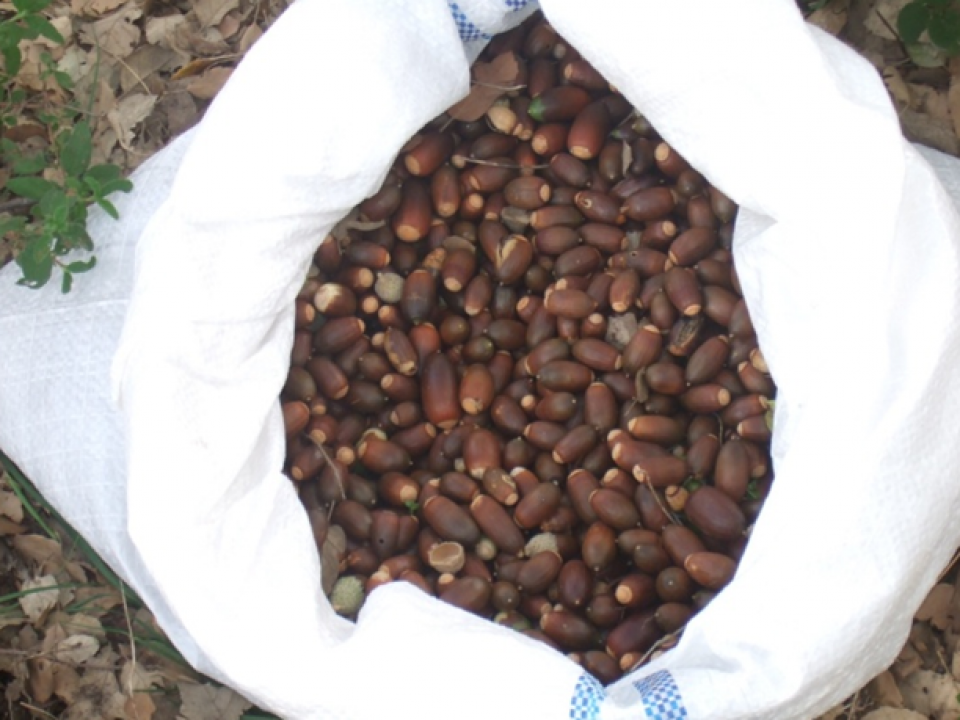
Solve the problem of the fragility of oak acorns used for reforestation and animal feed by improving the process of their conservation for a period close to a year.
Oak acorns offer a considerable potential as a NWFP. Besides their importance in reforestation and animal feeding, their use in human food begins to generate interest. Every year, In addition to production irregularity, a large part of oak acorns is lost or altered and its quality deteriorates over time. Acorns are known as recalcitrant seeds and should be then treated as fruits. They cannot be stored with forest seeds. Their storability is, particularly, difficult because they do not withstand even moderate dehydration (minimal moisture content over 30%) and do not tolerate strongly negative temperatures and because of pathogenic fungi hence the importance of a methodology that overcomes this problem.
The acorns conservation of is a set of processes beginning from the harvest to the storage. After 8 months of acorns storage, water content, germination and infestation percents were used as quality indicators.
- Acorns harvested directly from trees and collected on tarps were better conserved than those collected directly on the ground.
- Acorns put in the cold room (temperature:+4 °C and relative humidity: 80%) were better stored than those put in the open air
- The packaging container of barrel (humidity content > 35%) was better than the jute bag and the plastic crate (P= 0.035<0.05).
- The best substrate in which acorns were well stored is the peat, compared with the pine needles and the absence of the substrate (P= 0.001).
- Fungicides had a preventative and non-curative action.
- During harvest, it is recommended to select good acorns including ripe fruits and excluding dead (empty) and rotten (pathogenic fungi) acorns and those with holes (insect pests).
- During storage it is recommended to:
- Disinfection of the cold room prior to storage
- Treat well-sorted acorns with a fungicide prior to storage and periodically as a preventative way to control the spread of fungi in healthy ones. The thermotherapy can be also used, especially, for acorns dedicated to animal feed: soak the acorns in hot water at 41° C for 3 hours then re-dry them gently.
- Pack the acorns in half full hermetic container and wrap them with peat (alternating layers of acorns and peat).
- Put acorns in an environment where the temperature range is between 0°C and 4°C and the relative humidity is equal to 80%.
- Periodically, stir and ventilate containers and control the viability and quality of acorns.
Impact: keeping acorns of good quality, in the medium term, will help foresters to shorten the stay of cork oak seedlings in nursery which reduce considerably the cost of their production and improve their quality increasing therefore the chances of a successful planting. It will also help to better managing acorns for livestock farming and hence improve the income of local population.
Weaknesses: In addition to irregularity of fructification, the cost of the acorn conservation process could be high in large scale. The use of fungicides could cause toxicity and deterioration in the quality of acorns.
Acorn harvest management deserves special attention from foresters, who should, through a participatory approach, find a compromise with the users of the forest to bear irregularity and operate the supply wisely. The ongoing and future researches on acorns conservation are diverse and are related not only to the regeneration of cork oak but also to the pastoral potential of acorns. They point, especially, at the decrease of the cost of the storage process the stretching of its duration. The use of natural antifungal products could also be interesting for the conservation of good quality acorns.
Boutheina STITI, stitibou@gmail.com, http://www.inrgref.agrinet.tn/
Faten MEZNI, faten-mez@hotmail.com, http://www.inrgref.agrinet.tn/
Sondes FKIRI, sondesfkiri@gmail.com, http://www.inrgref.agrinet.tn/
Abdelhamid KHALDI, khalditn@yahoo.fr, http://www.inrgref.agrinet.tn/
Further information
Boutheina STITI. 2015. La conservation des glands de chêne-liège: un maillon important de la régénération. Fiche technique FAO in Filière des semences forestières et pastorale en Tunisie. Annexe 2 (141-143).Fao-Direction Générale des Forêts (DGF).Tunisie.
Boutheina Stiti

Boutheina Stiti
